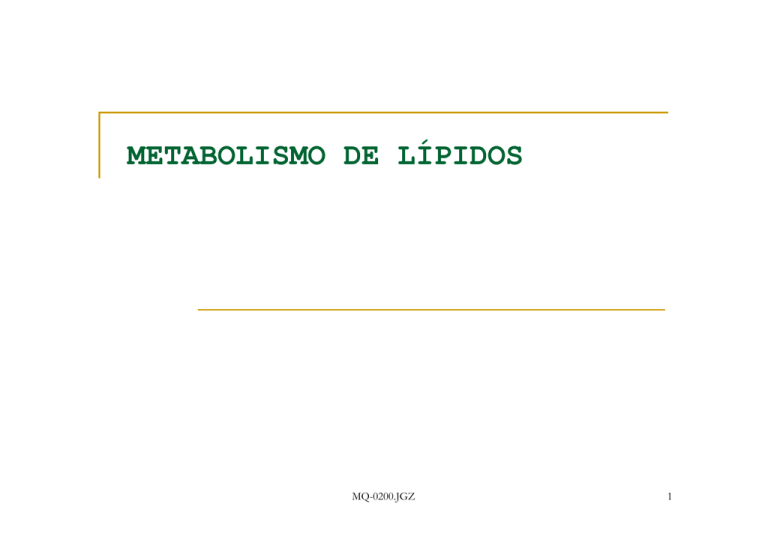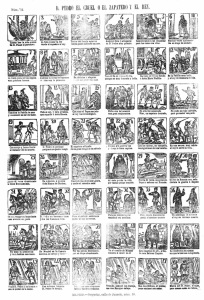METABOLISMO DE LÍPIDOS
Anuncio

METABOLISMO DE LÍPIDOS MQ-0200.JGZ 1 Destino de los lípidos absorbidos: Carbohidratos o lípidos de la alimentación → Acetil CoA ↔ Ác. Grasos ↔ TAG Cuerpos cetónicos Krebs Colesterol y esteroides MQ-0200.JGZ 2 LIPÓLISIS Hay una triacilglicerol lipasa sensible a hormonas. MQ-0200.JGZ 3 Figure 14.9 Regulation of lipid metabolism by glucagon and epinephrine. Glucagon and epinephrine activate hormone-sensitive lipase in adipose tissue, in coordination with activation of proteolysis in muscle and gluconeogenesis in liver. Metabolism of fatty acids through β-oxidation in liver yields ATP for gluconeogenesis. The MQ-0200.JGZ acetyl-CoA is converted to and released to blood as ketone bodies. These effects are reversed by insulin following a meal. 4 β-OXIDACIÓN Y CETOGÉNESIS Oxidación secuencial de los átomos en posición beta. El ácido graso se activa en el citoplasma y el resto del proceso ocurre en la mitocondria. Enzimas separadas. Coenzimas NAD+ y FAD. Estimulada por el ADP. Requiere oxígeno. No es activada por el citrato o el Acil CoA. En inanición y diabetes aumentan beta oxidación y cetogénesis → cetoacidosis. MQ-0200.JGZ 5 β-OXIDACIÓN Y CETOGÉNESIS El AGL se activa uniéndose a la CoA, participa la acil CoA sintetasa, ATP, pirofosfatasa). El Acil CoA se une a la carnitina y entra a la mitocontria por la carnitin-palmitoil transferasa. Se produce suscesivamente Acetil CoA, NADH+H+ y FADH2 MQ-0200.JGZ 6 Figure 14.1 Activation of fatty acids by fatty acyl-CoA synthetase (thiokinase). ATP forms an enzyme-bound acyl adenylate intermediate, which is discharged to form acyl CoA. AMP, adenosine monophosphate; CoASH, coenzyme A; PPi, inorganic pyrophosphate. MQ-0200.JGZ Downloaded from: StudentConsult (on 31 January 2007 04:22 PM) © 2005 Elsevier 7 Figure 14.2 Transport of long-chain fatty acids into the mitochondrion. The three components of the carnitine pathway include extra- and intra-mitochondrial CPTs and the carnitine-acyl carnitine translocase. MQ-0200.JGZ Downloaded from: StudentConsult (on 31 January 2007 04:22 PM) © 2005 Elsevier 8 β-OXIDACIÓN Y CETOGÉNESIS Se produce suscesivamente Acetil CoA, NADH+H+ y FADH2 MQ-0200.JGZ 9 Figure 14.3 Overview of β-oxidation of palmitate. In a cycle of reactions, the carbons of the fatty-acyl-CoA are released in two-carbon acetyl-CoA units; the yield of 35 ATP from this β-oxidation is nearly equivalent to that from complete oxidation of glucose. In liver, the acetyl CoA units are then used for synthesis of ketone bodies, and in other tissues they are metabolized in the TCA cycle to form ATP. The complete oxidation of palmitate yields a net 129 moles of ATP, after correction for the 2-mole equivalents of ATP invested at the thiokinase reaction. The overall production of ATP per gram of palmitate is about twice that per gram of glucose, because glucose is already partially oxidized in comparison with palmitate. For this reason, as illustrated in Table 14.2, the caloric value of fats is about twice that of sugars. MQ-0200.JGZ © 2005 Elsevier 10 Figure 14.4 β-Oxidation of fatty acids. Oxidation occurs in a series of steps at the carbon that is β to the keto group. Thiolase cleaves the resultant βketoacyl-CoA derivative to give acetyl-CoA and a fatty acid with two fewer carbon atoms, which then re-enters the β-oxidation cascade. Note the similarity between these reactions and those of the TCA cycle, shown on the right. MQ-0200.JGZ 11 β-OXIDACIÓN Y CETOGÉNESIS A partir del acetoacetil CoA se forma HMG-CoA y acetoacetato que luego se convierte en acetona (por descarboxilación) o hidroxibutirato (por reducción)(cuerpos cetónicos) MQ-0200.JGZ 12 Figure 14.7 Pathway of ketogenesis from acetyl-CoA. Ketogenesis generates ketone bodies from acetyl-CoA, releasing the CoA to participate in β-oxidation. The enzymes involved, HMG-CoA synthase and lyase, are unique to hepatocytes; mitochondrial HMG-CoA is an essential intermediate. The initial product is acetoacetic acid, which may be enzymatically reduced to β-hydroxybutyrate by β-hydroxybutyrate dehydrogenase, or may spontaneously (nonenzymatically) decompose to acetone, which is excreted in urine or expired by the lungs. MQ-0200.JGZ 13 β-OXIDACIÓN Y CETOGÉNESIS La β-oxidación se reduce por inhibición de la carnitina acil transferasa por aumento de malonil CoA. La cetogénesis aumenta por: Aumento en lipólisis porque aumenta los AGL. Disminución de la esterificación de AcilCoA a acilgliceroles en la mitocontria con lo que sube la βoxidación. Disminución de Krebs y aumento de la cetogénesis. MQ-0200.JGZ 14 Figure 14.8 Catabolism of ketone bodies in peripheral tissues. Succinyl-CoA: acetoacetate CoA transferase activates the transfer of acetoacetate to acetoacetyl CoA. A thiokinase-type enzyme may also directly activate acetoacetate in some tissues. MQ-0200.JGZ 15 LIPOGÉNESIS Toma glucosa y sus productos para almacenarlos en forma de lípidos. Dieta rica en CHO aumenta la síntesis de Acetil CoA carboxilasa y la lipogénesis. Baja ingestión calórica, alta ingesta de grasas, deficiencia de insulina → ↑ AGL y ↓ lipogénesis MQ-0200.JGZ 16 LIPOGÉNESIS Ocurre en el citosol de tejidos pulmón, riñón, mama, adiposo. Requiere: NADPH+H+, ATP, Mn+2 y HCO3- Sustrato: acetilCoA. Producto final: palmitato. MQ-0200.JGZ como hígado, 17 LIPOGÉNESIS Los derivados acilo están adheridos a un complejo multienzimático. Estimulada por el ATP. Activado por el citrato. Baja ingestión calórica, alta ingesta de grasas, deficiencia de insulina → ↑ AGL y ↓ lipogénesis MQ-0200.JGZ 18 LIPOGÉNESIS Reacción limitante: Carboxilasa. Esta enzima fosforilada está inactiva. Inhibidores: de la acetil CoA Glucagón: la Sube AMPc con lo que aumenta lipólisis (sube el nivel de acilCoA de cadena larga). El AMPc activa a la quinasa de la acetil CoA carboxilasa. Acil CoA de cadena larga. Palmitoil CoA MQ-0200.JGZ 19 LIPOGÉNESIS Activadores: Citrato (alimentación alta) Insulina: Aumenta el transporte de Glu y la disponibilidad piruvato, Activa la PDH en adiposo Reduce AMPc y con ello se desactiva la lipólisis MQ-0200.JGZ de 20 Figure 15.1 Conversion of acetyl-CoA to malonyl-CoA. Acetyl-CoA carboxylase is covalently attached to biotin, which is carboxylated using a molecule of ATP. The enzyme requires the presence of citrate for polymerization to its active form. It is also regulated by insulin, independently of the citrate-stimulated polymerization. cAMP, MQ-0200.JGZ cyclic adenosine monophosphate. 21 LIPOGÉNESIS La sintasa de ácidos multienzimático. grasos Tiene 2 monómeros o unidades polipeptídicas cada uno con 6 actividades separadas. MQ-0200.JGZ es un complejo 22 Figure 15.3 Reactions catalyzed by fatty acid synthase. The cyclical part of the fatty acid biosynthesis is completed six times to release one 16-carbon molecule of MQ-0200.JGZ palmitate. NADPH, reduced nicotinamide dinucleotide phosphate; pan, pantetheine. 23 LIPOGÉNESIS El palmitato es liberado por la actividad tioesterasa que tiene mayor actividad por ácidos grasos C16. Ecuación completa: AcetilCoA + 7 MalonilCoA + 14 NADPH + 14 Palmitato + 7 CO2 + 6 H2O + 8 CoASH + 14 MADP+ MQ-0200.JGZ H+ → 24 LIPOGÉNESIS El alargamiento de la cadena ocurre principalmente en el retículo endoplásmico. Usa AcilCoA y MalonilCoA. El ácido graso se desatura en el retículo endoplásmico con desaturasas ∆9, ∆6, ∆5 y ∆4. MQ-0200.JGZ 25 Figure 15.5 Elongation of fatty acids. Fatty acid elongation occurs on the MQ-0200.JGZ endoplasmic reticulum and is carried out by another enzyme complex, fatty acid elongase. 26 LIPOGÉNESIS El ácido graso se desatura en el retículo endoplásmico con desaturasas ∆9, ∆6, ∆5 y ∆4 mediante la cadena microsómica de transporte de e- MQ-0200.JGZ 27 Figure 15.6 Desaturation of fatty acids. Human desaturases cannot introduce a double bond between carbon 9 and the methyl (ω) end of the fatty acid. This (CH2)7 represents the limit at which a double bond can be introduced. cyt b5, cytochrome b5; FAD, flavin adenine dinucleotide; FADH2, reduced flavin adenine dinucleotide; MQ-0200.JGZ Fe3+, ferric ion. 28 ESTERIFICACIÓN Glicerol a glicerol 3 P por la glicerol quinasa. En adiposo dihidroxiacetona glucólisis a glicerol 3 P. Re-esterificación de ácidos grasos por medio de acilCoA sintetasa y acil transferasa. MQ-0200.JGZ P de la 29 Figure 15.7 Triacylglycerol synthesis. Triacylglycerols (TAGs), also called triglycerides, are synthesized in adipose tissue and the liver. The source of glycerol-3-P is MQ-0200.JGZ different in the two tissues, because there is no glycerol kinase in adipose tissue. 30 LIPOPROTEÍNAS Y TRANSPORTE DE LÍPIDOS MQ-0200.JGZ 31 Figure 15.8 Transport and storage of fat in response to feeding. The relationship between the biosynthesis of fatty acids in the liver, their export as VLDL, and increased storage of fat as triacylglycerols (TAGs). Insulin is an important regulator of this pathway. In the liver, it stimulates glycolysis, thereby increasing pyruvate production. It activates the pyruvate dehydrogenase complex (by causing its dephosphorylation), and thus promotes synthesis of acetyl-CoA. This stimulates the TCA cycle and increases the concentration of citrate. Citrate stimulates acetyl-CoA carboxylase, increasing the rate of fatty acid biosynthesis. F-1,6-BP, fructose-1,6 biphosphate; IDL, intermediate-density lipoprotein. (See MQ-0200.JGZ also Chapter 17 for details of lipoprotein metabolism.) 32 COLESTEROGÉNESIS Hasta la formación de HMG-CoA es igual que la cetogénesis. MQ-0200.JGZ 33 Figure 16.2 Biosynthesis of mevalonic acid. Mevalonic acid contains six carbon atoms, which are derived from three molecules of acetyl CoA. MQ-0200.JGZ 34 COLESTEROGÉNESIS Luego el mevalonato pasa sucesivamente por isopentenil, farnesil, escualeno, lanosterol y colesterol: 3 Acetil CoA + 2 NADPH → Mevalonato (6C,1COO-, 2OH) HMG-CoA reductasa Insulina + Glucagón - MQ-0200.JGZ 35 COLESTEROGÉNESIS CO2 NADPH Mevalonato → Isopreno → Escualeno (30 C) ↓ NAPH Lanosterol (se cierra) ↓ NADPH 3 CH3 Colesterol MQ-0200.JGZ 36 Figure 16.5 Biosynthesis of cholesterol. These reactions occur while bound to a squalene- and sterol-binding protein. FAD, flavin adenine dinucleotide; NADH, reduced nicotinamide adenine dinucleotide. MQ-0200.JGZ 37 Figure 16.1 Structure of cholesterol. A-D is the conventional notation used to describe the four rings. Numbers 1-27 describe the carbon atoms. MQ-0200.JGZ 38 COLESTEROGÉNESIS A partir del colesterol se sintetizan otros esteroides importantes: sales biliares, hormonas, vitamina D. MQ-0200.JGZ 39 Figure 16.6 Structure of bile acids. Primary bile acids are synthesized in the liver and secondary bile acids in the intestine. MQ-0200.JGZ 40 Figure 16.7 Structure and nomenclature of the most important human steroid hormones. Their trivial and systematic (in parentheses) names are shown. For the biosynthetic pathways, see Fig. 37.7. For numbering of the atoms in a steroid molecule, see Fig. 16.1. MQ-0200.JGZ 41 Figure 16.8 Formation and hydroxylation of vitamin D3 (cholecalciferol) MQ-0200.JGZ 42 CAMBIOS EN EL METABOLISMO DE CARBOHIDRATOS Y LÍPIDOS CON EL AYUNO 1. ↓ Glicemia. 2. ↓ Insulina y ↑ Glucagón. 3. ↓ Glucógeno glucogenólisis. 4. ↑ AGL (se van a β-oxidación) y glicerol (se va a gluconeogénesis) por lipólisis. 5. ↑ Cuerpos cetónicos por cetogénesis. hepático MQ-0200.JGZ y muscular por ↑ 43 ANORMALIDADES DEL METABOLISMO DE LÍPIDOS 1. Deficiencias en el metabolismo de carnitina: Características: Los síntomas se presentan en la infancia y duran toda la vida: hipoglicemia hipocetónica, hiperamonemia, concentración de carnitina libre plasmática alterada, es común daño hepático, cardiomiopatía, y debilidad muscular. Comentario: Hígado y riñón sintetizan carnitina de lisina y α-cetoglutarato, nivel en plasma normal es de 0.8 mg/dl, hay sistemas de captura de alta afinidad en la mayoría de los tejidos. Deficiencias en CPTI y II y en la translocasa afectan la oxidación de ácidos grasos. Tratamiento es con suplementos de carnitina, con alimentación rica en carbohidratos frecuentemente y evitando el ayuno. MQ-0200.JGZ 44 ANORMALIDADES DEL METABOLISMO DE LÍPIDOS 2. Cetonuria y programas de pérdida de peso: Características: Cetonuria puede aparecer en dietas reducidas en CHO y calorías. Comentario: La detección de cuerpos cetónicos en la orina por medio de tiras reactivas se recomendaba para dar seguimiento a dietas que estimulan metabolismo de lípidos, pero ello se asocia con más altos niveles de cuerpos cetónicos en plasma y posible acidosis metabólica. MQ-0200.JGZ 45 ANORMALIDADES DEL METABOLISMO DE LÍPIDOS 3. Anormalidad de lípidos en el alcoholismo: Características: Mujer de 36 años con TAG=6388 mg/dl, CHOL=503 mg/dl, consume 3 botellas de vodka y 6 de vino por semana. Al dejar el consumo de alcohol TAG=175 y CHOL=193. Comentario: En alcoholismo aumenta NADH hepático, la alta relación NADH/NAD inhibe la oxidación de ácidos grasos, los ácidos grasos entonces se esterifican a TAG. Al inicio del alcoholismo, éstos se exportan como VLDL, pero luego disminuye la capacidad de síntesis de apolipoproteínas hepáticas y se acumula TAG en el hígado. MQ-0200.JGZ 46 ANORMALIDADES DEL METABOLISMO DE LÍPIDOS 4. Obesidad: Características: Hombre de 48 años, 1.91 m, con incremento de peso desde los últimos 8 años cuando se retiró del ejército. Subió de 95 a 193 Kg., sin cambio en la dieta pero con menos actividad física, consume de 3 a 4 mil kcal/día con 40% grasa. Se puso en una dieta, con reducción de consumo de grasa, ejercicio. Bajó rápidamente de peso, luego lentamente, hasta 145 Kg. Luego, con una dieta alta en proteína, baja en CHO y lípidos, llegando a un peso de 93 kg. en un año. Comentario: IMC=Kg./m2 indica grados de obesidad I, II o III si IMC es 25-30, 3040, o más de 40. Este paciente comenzó con IMC de 53, y terminó en 26. MQ-0200.JGZ 47

